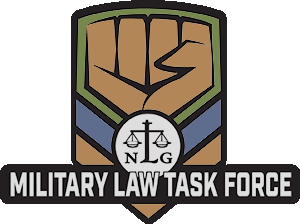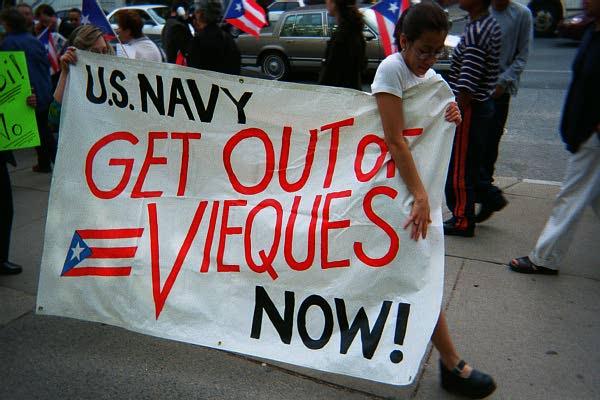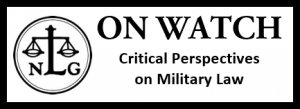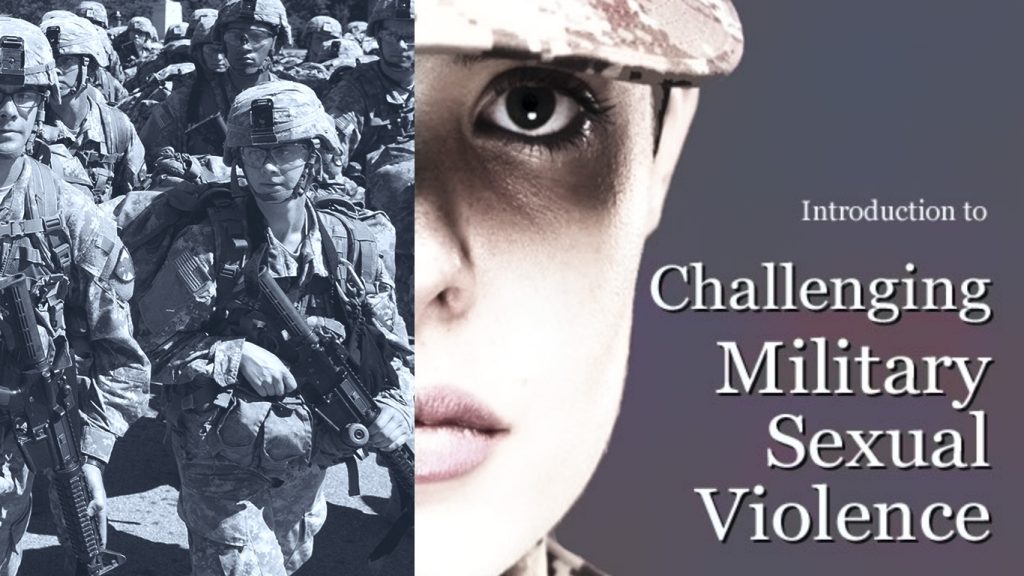By Helen Jaccard and David Swanson
Originally published in the September 2013 issue of On Watch, the MLTF quarterly newsletter.
Ten years ago May 1, the people of Vieques, Puerto Rico, and their supporters defeated the most powerful military machine ever, through mass civil disobedience and without firing a single shot. On May 1, 2003, the U.S. military put a stop to six decades of nonstop bombing, munitions dumping, war games, and poisoning the small island seven miles from the coast of Puerto Rico, activity that involved depleted uranium, Agent Orange, napalm and heavy metals. Vieques, and the bases were officially closed. People from all over the world supported the struggle on Vieques, and the activists and residents have an incredible victory to celebrate.
There were decades of resistance, civil disobedience and arrests, while the U.S. military “rained down” a trillion tons of ordnance over the course of six decades on an island scarcely the size of Santa Catalina in California or Nantucket in Massachusetts. But those hoping and laying the groundwork for greater resistance were given an opportunity on April 19, 1999, when a U.S. Marines pilot missed his target and killed civilian security guard David Sanes Rodriguez. That spark lit a fire of nonviolent resistance that brought together Viequenses, Puerto Ricans, and supporters from the United States and around the world. A campaign of non-violent civil resistance that began in 1999 lasted four years, including a year-long occupation of the bombing range, and saw over 1,500 people arrested. The Navy was forced to close the bombing range on May 1, 2003. Peace-loving people had won the first of their demands for the island: demilitarization.
A huge commemoration occurred in Vieques for the anniversary from May 1 – 4, 2013.
Island beauty belies environmental catastrophe
Beautiful Vieques Island is only 21 miles across, five miles wide, and home to about 9,300 people, as well as endangered turtle species, rare Caribbean plants and animals, bio-luminescent bays, and miles of what look like unspoiled beaches. But crabs with three claws, grossly deformed fish laden with heavy metals, once-beautiful coral reefs, and beaches and seas that have been decimated by military activity tell a story of environmental disaster with huge health impacts on people, plants, and animals.
An incredible three-quarters of the island was appropriated in the 1940s and used by the U.S. Navy for bombing practice, war games, and dumping or burning old munitions. This was a terrible attack on an island municipality, one the United States was not at war with.
Now, Vieques Island, a paradise in trouble, is one of the largest Superfund sites in the United States, together with its little sister island of Culebra, which took the brunt of the bombing until 1973, when the Culebra bombing range closed (also due to protests) and the bombing practice was transferred to Vieques.
U.S. Has Yet to Relinquish Control
In 2003, the Navy did not return the land to the people, but transferred its Vieques land to the U.S. Fish and Wildlife Service, which operates beaches that were never used for military activities.
Viequenses fear that keeping the U.S. Government in control of their lands could result in future re-militarization of the island. Residents are unhappy that their land has not been returned to them and that they are fined for staying on their land past sunset or collecting crabs — a mainstay of their historic diet. There are also two military occupations of lands — a ROTHR radar system and a communications area, and the people want these closed as well. You can add your name to Viequenses’ demand for peace here.
For over 2,000 years people known as Taino inhabited Vieques, which they called Bieque. The Taino found and left behind them a paradise of fertile soil, fresh water, and trees. In 1493, the conquistadors arrived, and by1524, the Spanish had killed every remaining resident. Vieques was then left uninhabited by humanity for 300 years, interrupted by a few British, French, and Spanish attempts to set up forts or destroy each other’s efforts.
The Spanish and French used Vieques to grow sugar from 1823 into the 1900s. English-speaking people of African origin from nearby islands were kept in slavery conditions, or the nearest thing to it, and forced to grow sugar cane. They revolted in 1864 and 1874, and in 1915 via the Sugar Strike. The United States took Puerto Rico from the Spanish in 1898 and made its residents U.S. citizens in 1917(Editor’s note: neatly timed to allow them to be conscripted to fight WWI). The Great Depression of the 1930s, together with two hurricanes in 1932, brought on harder times than ever.
In 1939 the United States bought 26,000 of the 30,000 acres of land on Vieques from big sugar plantation owners. Living on that land were 10,000 to 12,000 workers who also raised crops to feed themselves. The U.S. Navy gave families $30 and one day’s notice before bulldozing houses. Most people were left without means of subsistence, but many stubbornly refused to leave the island.
Carlos Prieta Ventura, a 51-year-old Viequense fisherman, says his father was 8 years old in 1941 when the Navy told his family their house would be bulldozed whether or not they accepted the $30. Ventura says he has always resisted the Navy’s efforts to force people off the island.
100,000 unexploded bombs litter land and sea
From 1941 to 2003, the U.S. military flew planes from aircraft carriers based on the main island of Puerto Rico and dropped bombs over Vieques. Explosives “rained down,” and personnel could feel the ground shake within the base, as one U.S. veteran told CNN. Bombs fell at all hours, all day, all week, all year, totaling approximately a trillion tons of ordnance, much of which (some 100,000 items) lies unexploded on land and in the sea.
Moreover, Vieques was systematically poisoned by heavy metals, napalm, Agent Orange, depleted uranium, and who knows what all else that the Navy has not announced publicly – having falsely denied using depleted uranium before finally admitting to it, and having dumped barrels of unknown toxic substances into the clear blue Caribbean.
The arsenic, lead, mercury, cadmium, and aluminum in the bombs are also found in hair samples of 80% of the people living on Vieques, who suffer at far higher rates than on the main island (and possibly anywhere else on earth) from cancer (30% higher than Puerto Rico), cirrhosis of the liver, kidney failure, hypertension (381%), diabetes (41%), birth defects, stillbirths, and miscarriages.
A dozen people were killed over the years directly by the U.S. weapons testing. And the Navy banned fishermen from various areas, advising them to try food stamps instead.
Impact and resistance
According to Ventura, the Viequense fisherman, a more direct and immediate impact of the U.S. occupation was felt as some 15,000 troops were routinely set loose on Vieques looking for booze and women. Women were dragged out of their homes and gang raped. A boy was reportedly killed by gang rape.
Lydia Ortiz, a Viequense who grew up in the small town of Esperanza, recalls the bombing: “A lot of houses had their roofs falling in and everything as a result of the vibrations from the bombs for many years. It was pretty nerve-wracking because you never knew what was going to crash down in your house. We lived quite close to where the bombing was happening. When I was a child they were dropping bombs near me. In the school, you could hear the bombing. You couldn’t even hear the teacher because of the noise. People were afraid to go anywhere near the base or the beach so it was very difficult for many years. It seems like just yesterday or only five or six years ago that the bombing stopped, even though it is really almost 10 years ago.”
Throughout the later years of the occupation, fishermen attempted civil resistance actions, and many were arrested during the 1970s, 80s, and 90s.
A celebration of the 10-year anniversary was indeed in order. We must remember victories, as they have remarkable power to motivate others around the world.
Continuing effects of Navy occupation
But the Navy’s presence and the environmental disaster it created continue to afflict Vieques today. The U.S. government has not cleaned up the poisons and bombs and continues to use practices that further endanger the people. There is no bomb explosion chamber on the island. The United States has disposed of what unexploded bombs it has by blowing them up, further spreading the contaminants that are killing the people of the island.
There is also no hospital on the island, few ferries to Puerto Rico, few and expensive flights, a handful of taxis and public vans, and very limited tourist facilities. There is no college or university, and very few jobs of any kind. Business licenses are issued in San Juan and require bribes. Viequenses’ families are ravaged by cancer, but also by illiteracy, unemployment, violent crime, and teen pregnancy. All of the water – like all electricity – comes in a pipe from the main island.
Two of the residents said that the one resort on Vieques sometimes uses all the water. Myrna Pagan, a long-time resident of Vieques, said, “If we had a real hospital people would just go to the hospital and you would have some preventive treatment. The abominable ferry service and the number of people that go over to the big island for medical treatment are all things that can be done here if the center were adequate.”
Courts refuse to hear islanders’ case
Seven thousand Viequenses sued the U.S. government over their health problems, but the U.S. Supreme Court refused to hear the case. The class action lawsuit was filed against the Navy by over 7000 of the island’s 9500 residents in 2005 by the law firm of John Arthur Eaves, Jr., a prominent Mississippi attorney. The plaintiffs asserted that the Navy failed to warn residents of any potential danger from the government’s military activities.
In 2010, the case was dismissed by a federal district court in Puerto Rico, and the dismissal was upheld in a 2-1 vote of the U.S. First Circuit Court of Appeals in 2012. Both of the courts said that the Navy had sovereign immunity, which gives the federal government discretion to carry out its activities without being sued, except where approved by Congress. The courts declined to judge the case on its merits.
The dissenting judge, Juan Torruella of Puerto Rico, wrote that the government should not have been shielded because it knew how toxic the bombings were but decided not to warn the people of Vieques. Torruella wrote, “Nowhere does the medieval concept of ‘the King can do no wrong’ underlying the doctrine of sovereign immunity sound more hollow and abusive than when an imperial power applies it to a group of helpless subjects. This cannot be a proper role for the United States of America.” The three judges agreed that Congress would be the proper venue for redress of the legitimate and serious concerns about health on the island.
Eaves said, referring to violations of the Clean Water Act of 1972, “The problem here is that the Navy was acting within its discretion when it was bombing the island. Yes, the Navy was doing what it was designed to do. But it violated the law, which is not within their discretion.”
Court excludes relevant evidence
The Environmental Protection Agency cited the Navy for violating the Clean Water Act by dropping too many bombs off the shores of Vieques. One year, the EPA cited the Navy 102 times. This evidence was not allowed to be presented to the court and Eaves said that the harm done by this bombing is just collateral damage under the doctrine of sovereign immunity.
Supporters of the Vieques residents have already turned to Congress as well as the courts.
“The Vieques Recovery and Development Act of 2011,” introduced by New Jersey Rep. Steve Rothman and Puerto Rico’s non-voting representative, resident commissioner Pedro Pierluisi, would have provided funding for a hospital and toxins research center for the island.
“The federal government was responsible for the military activities there, the least they should be doing is coming up with a plan so that all the agencies involved would do whatever testing needs to be done at the federal government’s expense,” said Pierluisi. “It’s the least they owe to the people of Vieques.”
The bill languished and died in committee and has not been re-introduced.
With very little land available for farming, Vieques, like all of Puerto Rico, imports almost all of its food. Some people have become so desperate that they gather old munitions to sell for a little money to someone who will melt the metal for aluminum cans. But heavy metals and depleted uranium endanger the metal gatherers and whoever later drinks from the cans.
Obama’s unfulfilled promise
Presidential candidate Obama wrote to the Governor of Puerto Rico in 2008: “We will closely monitor the health of the people of Vieques and promote appropriate remedies to health conditions caused by military activities conducted by the U.S. Navy on Vieques.” But that promise remains unfulfilled.
In a letter to the President, Robert Rabin Siegal of the Committee for the Rescue and Development of Vieques writes:
Although I cannot claim the Navy and military toxics caused my cancer, you don’t have to be a quantum physicist to understand how decades of exposure to heavy metals in the food chain, air, water and land, combined with the socio-economic pressures from the loss of two thirds of the island’s lands, would clearly contribute to high cancer rates. The Navy dropped radioactive uranium projectiles here, we believe, in large quantities, in preparation for military actions in the Balkans and the Middle East. The list of dangerous chemical components from munitions dropped on Vieques is extensive, as is the number of illnesses they cause.
Mr. President: you received the Nobel Peace Prize; we demand peace for Vieques. An island and people used to protect U.S. interests since WWII, forced to sacrifice its land, economic prosperity, tranquility and health, deserves at least the hope of peace for this and future generations. . . .
A handful of powerful U.S.-based corporations have pocketed most of the more than $200 million spent on clean-up over the past decade. We urge you to order technology transference to promote the creation of Puerto Rican and Viequense companies to carry out the clean-up of Vieques, thereby transforming that process into part of the economic reconstruction of the island as well as assuring community confidence in this crucial element in the healing of Vieques.
People anywhere in the world can take one minute to sign a petition to the Pentagon, Congress, and the White House in support of justice, at long last, for Vieques:
I join the people of Vieques in demanding:
Health Care – Provide a modern hospital with cancer treatment facilities, early screening and timely treatment for all diseases. Create a research facility to determine the relationship between military toxins and health. Provide just compensation to people suffering poor health as a result of the Navy’s activities.
Cleanup – Fund a complete, rapid cleanup of the land and surrounding waters, still littered by thousands of bombs, grenades, napalm, Agent Orange, depleted uranium and other explosives left by the Navy. Cease the ongoing open detonation of unexploded ordnance. Guarantee community participation in the cleanup; train Viequenses as managers, administrators, and scientists, and foster Viequense companies to do the work.
Sustainable Development – Support the Master Plan for Sustainable Development of Vieques which promotes agriculture, fishing, eco-tourism, small guest houses, housing, collective transportation, archaeology, and historic and environmental research, among other things.
Demilitarization and Return of the Land – Close the remaining military installations still occupying 200 acres of Vieques. Return to the people of Vieques all land still under the control of the U.S. Navy and the federal government.
For extensive documentation, see the attachments posted at warisacrime.org/vieques and other files hosted at this Dropbox public folder.
Addendum by MLTF Editors:
▪ Supreme Court rejects Vieques pollution case against U.S.: Sanchez et al. v. United States, 671 F.3d 86 (1st Cir. Feb. 14, 2012).
▪ Press Release: U.S. Supreme Court Ruling Indemnifies The Navy For Damages To The Puerto Rican Island of Vieques (Committee for the Rescue & Development of Vieques)
▪ March 2013 Report by Federal Agency for Toxic Substances & Disease
Helen Jaccard is Chair of the Veterans for Peace Environmental Cost of War and Militarism Working Group. She spent October 2012 in Vieques doing research about the environmental and health effects of the military activities. Her
previous article about Sardinia, Italy, can be found at
warisacrime.org/sardinia.
David Swanson’s books include “War Is A Lie.” He blogs at davidswanson.org and warisacrime.org and works for Roots Action. He hosts Talk Nation Radio.



